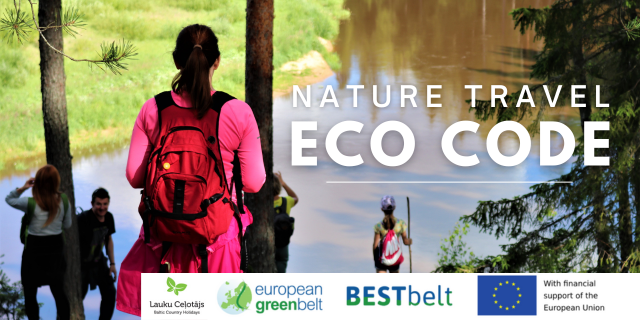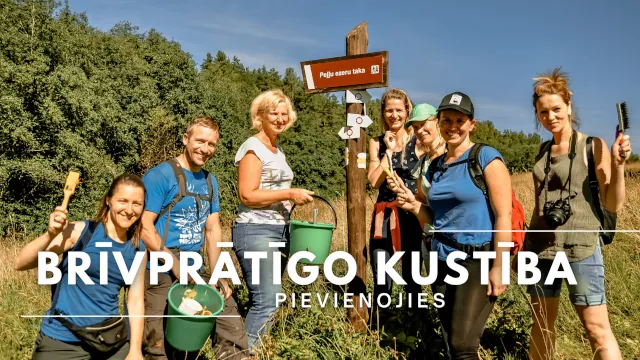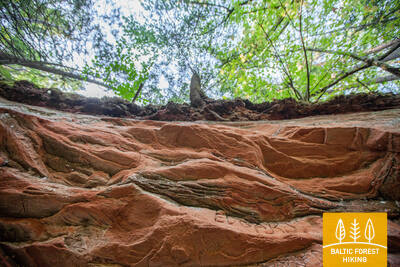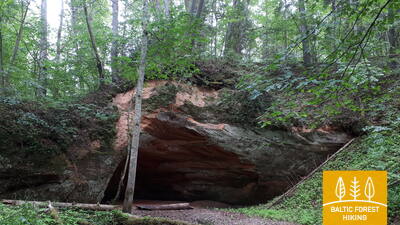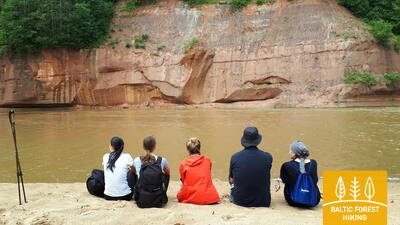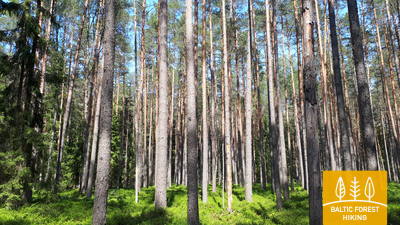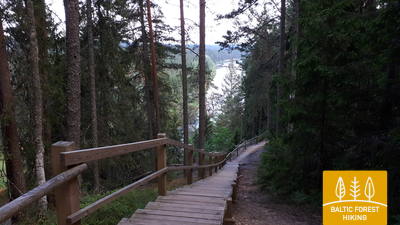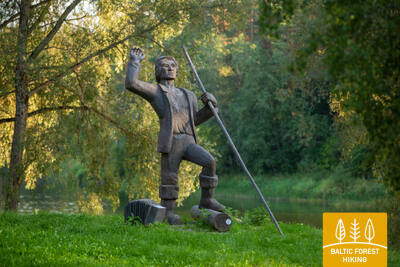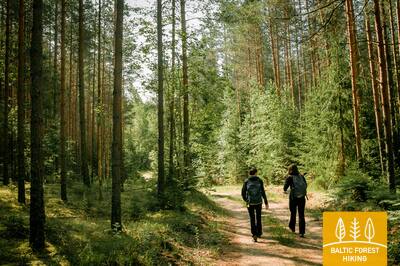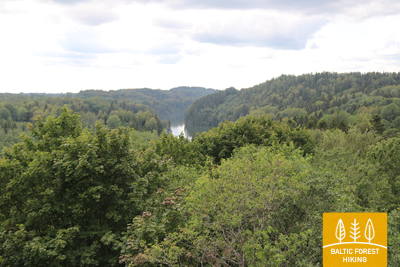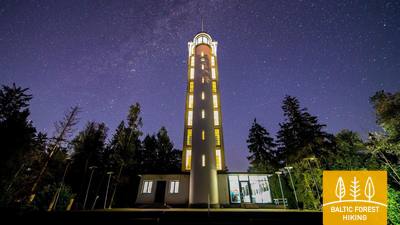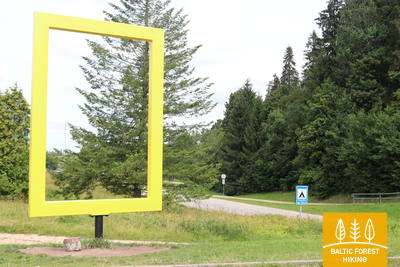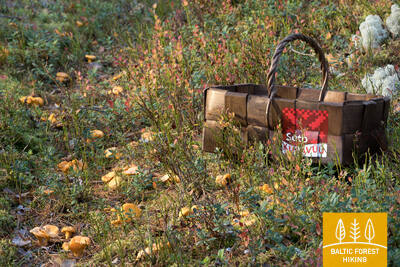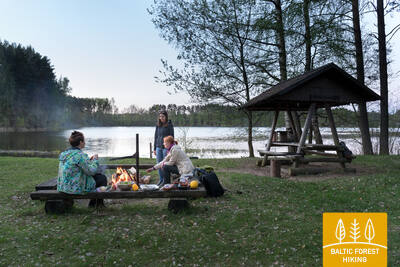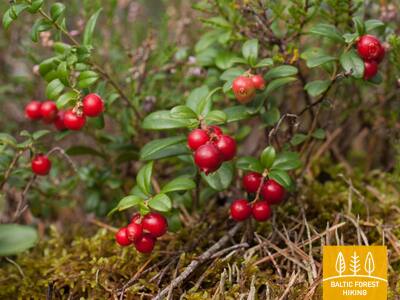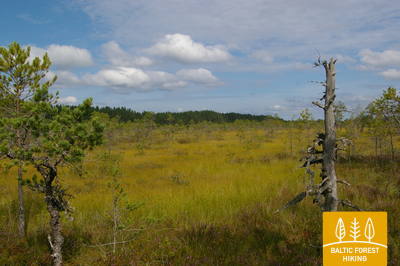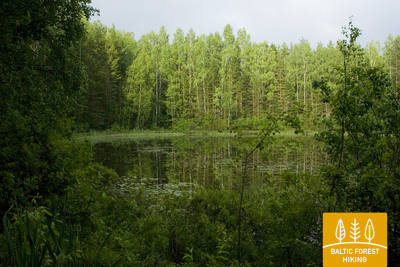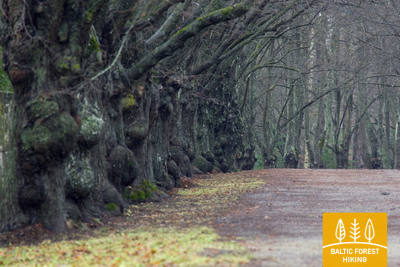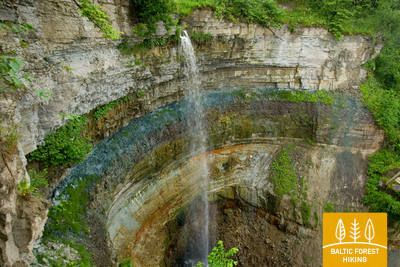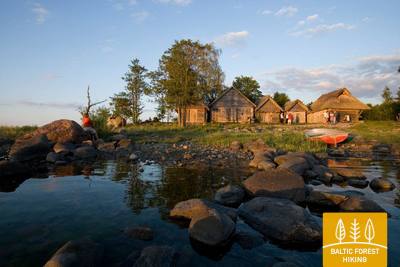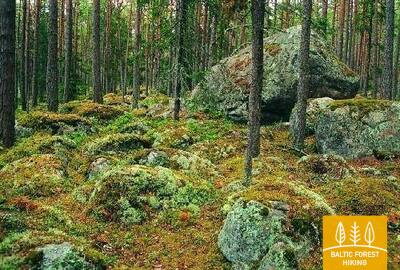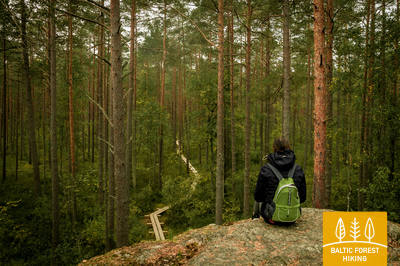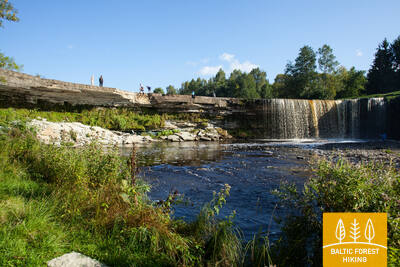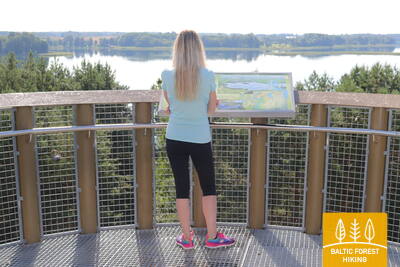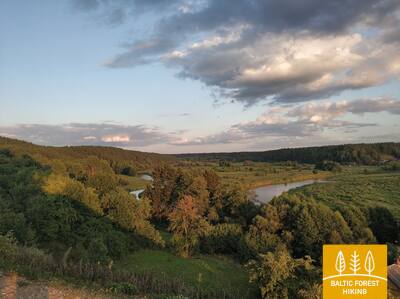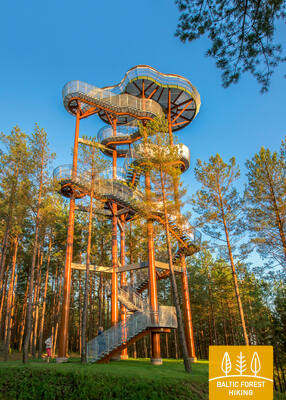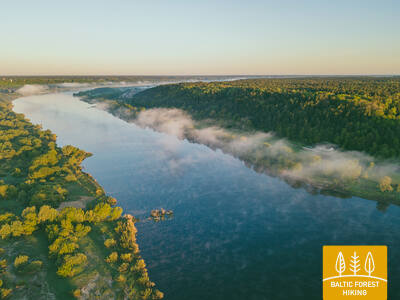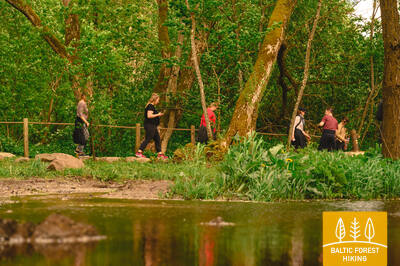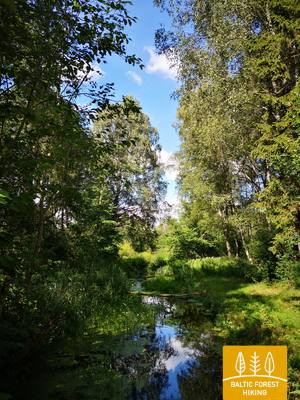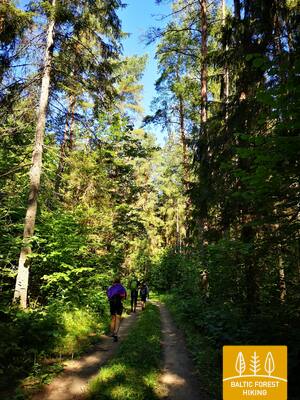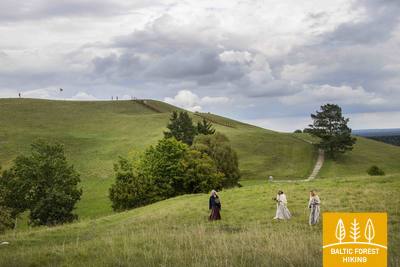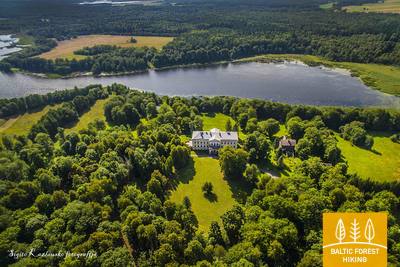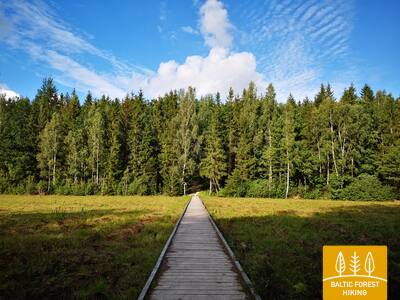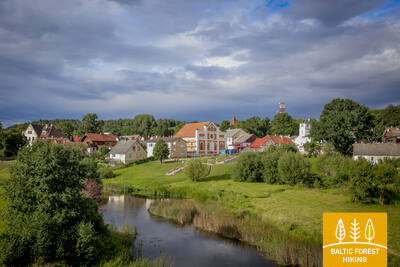Baltic Forest Hiking - Nature delight
 4. päev. Rāmkalni‒Sigulda.
4. päev. Rāmkalni‒Sigulda.
Maaliline Gauja jõe ürgorg Sigulda lähedal
Metsa matkarada kulgeb sel päeval Gauja jõe ürgoru järskudel nõlvadel, läbib Gauja küla ja suundub seejärel oru põhja, kus ületab Lorupe jõe ja jätkub Gauja jõe käänulistel kallastel. Rada möödub Velnala paljandist, ühest kauneimast liivakivipaljandist Gauja jõel. Seejärel suundub matkarada Ķeizarskatsi vaateplatvormile ja keerleb siis allapoole Ķeizarkrēslsi külla, möödudes Sigulda seikluspargist „Tarzan“ ja Sigulda bobi- ja kelgurajast.
Lõik läbib Gauja rahvusparki. Teatud kohtades avanevad avarad vaated Gauja jõe orule ja devoni liivakivipaljanditele Gauja jõe ja selle lisajõgede kaldal, kus asuvad paljud kultuuri- ja ajaloomälestised. Gauja rahvuspark sobib taimede, putukate, eluslooduse ja lindude avastamiseks. Sügisel saab vaadelda rändlõhet, külastada pargi loodus- ja õpperadasid ning käia seenel ja marjul. Üks muljetavaldavamaid vaatamisväärsusi Rāmkalni - Sigulda lõigul on Devil's Rock.
 5. päev. Sigulda‒Līgatne.
5. päev. Sigulda‒Līgatne.
Gauja rahvuspargi südames
Pärast Siguldat suundub metsa matkarada piki Vējupīte jõge Maalilise mäeni, kus järsk trepp viib alla Gauja jõe ürgorgu ja Vējupīte jõe sügavasse orgu. Seejärel lookleb rada üle niitude, ületades mõned väiksemad jõed, mille kallastel kõrguvad liivakivipaljandid. Teekonna viimased 6 km kulgevad mööda Līgatne loodusrada. Līgatnele lähenedes suundub metsa matkarada Gauja oru kõrgematele kallastele, kuni laskub taas alla, Līgatne jõe sügavasse orgu, kus asub endine Līgatne paberitööstus.
Lõik läbib Gauja rahvusparki. Erinevatest punktidest avanevad avarad vaated Gauja jõe orule ja devoni liivakivipaljanditele Gauja jõe ja selle lisajõgede kaldal, kus on palju kultuuri- ja ajaloomälestisi. Gauja rahvuspark on ideaalne taimede, putukate, eluslooduse ja lindude avastamiseks. Sügisel saab vaadelda rändlõhet, külastada pargi loodus- ja õpperadasid ning käia seenel ja marjul. Sigulda - Līgatne lõik on üks pargi kaugemaid piirkondi. Läti metsloomadega tutvumiseks tasub külastada Līgatne loodusradasid.
 6. päev. Līgatne‒Cēsis.
6. päev. Līgatne‒Cēsis.
Piki vana Cēsise teed läbi Amata jõe oru
Metsa matkaraja üks kõige maalilisemaid lõike kulgeb läbi Līgatne paberivabriku ajaloolise töölisküla, möödub Spriņģi paljandist, tiirutab mööda Skaļupe matkarada ja mütoloogilist rada, põikab läbi ühest Nõukogude aja kõige salajasemast kohast – suurest maa-alusest punkrist ‒ siinpool raudset eesriiet ning suundub edasi Roči looduskaitsealale, ületab Amata jõe (selles lõigus on Amata kõige ilusam ja paljandirohkem) ning jõuab lõpuks välja Zvārte paljandini. Järgmiseks kulgeb metsa matkarada Amata oru kõrgetel kallastel ning suundub mööda ajaloolist Cēsise–Riia “maanteed” (praegu väike külavahetee, mille ääres on vanad teetähised) Rakšisse, tõuseb üles Vāļukalni mägedele ja Ozolkalnsi. Gauja jõe kaldaid pidi edasi suundudes kohtub metsa matkarada Cīrulīši loodusradadega. Päeva teekond lõpeb Gauja tänaval, kuid matkajad võivad kõndida rada mööda edasi Cēsisesse (2,8 km), veeta seal öö ning jätkata sealt järgmisel päeval teekonda.
Lõik läbib Gauja rahvusparki. Teatud kohtades avanevad avarad vaated Gauja jõe orule ja devoni liivakivipaljanditele Gauja jõe ja selle lisajõgede kaldal, kus on palju kultuuri- ja ajaloomälestisi. Gauja rahvuspark on ideaalne taimede, putukate, eluslooduse ja lindude avastamiseks. Sügisel saab vaadelda rändlõhet, külastada pargi loodus- ja õpperadasid ning käia seenel ja marjul. Līgatne – Cēsise lõik on maaliliselt mitmekesine, kuna see kulgeb mööda Gauja ja Amata jõgesid – Läti kiirevoolulisi jõgesid –, kus on arvukalt liivakivipaljandeid ja Zvārtese kalju, mis on pargi üks populaarsemaid devoni paljandeid.
 7. päev. Cēsis‒Caunītes.
7. päev. Cēsis‒Caunītes.
Muljetavaldavad liivakivipaljandid Gauja jõel
Metsa matkarada kulgeb väikestel metsateedel kuni „Lenči“ kämpinguni, tiirutab läbi muutuva maastiku Ērģeļu paljandini ja laskub siis Gauja jõe ürgorgu. Pärast Ērģeļu paljandit suundub rada tagasi Cēsise suunas, kuid keerab Pieškalnsis ära Rāmnieki suunas, ületades Gauja jõe. Olles möödunud Jāņrāmise kämpingust, jõuab metsa matkarada ilusasse valgusrikkasse männimetsa ning kulgeb läbi metsa Caunītese turismitaluni. See on üks kõige ilusamaid kohti Gauja jõe kallastel.
Metsarada lookleb läbi Gauja rahvuspargi. Park on ideaalne taimede, putukate, eluslooduse ja lindude uurimiseks. Sügisel saab vaadelda rändlõhesid ning külastada pargi loodus- ja õpperadu. Cēsise – Caunīši lõigul on Gauja jõe oru üks muljetavaldavamaid devoni liivakivipaljandeid – Ērģeļu kaljud –, kuhu on rajatud loodusrada.
 8. päev. Caunītes‒Valmiera.
8. päev. Caunītes‒Valmiera.
Teel Valmierasse, rohelisse linna
Metsa matkarada suundub läbi lummavate männimetsade ja märgalade, üle ja ümber küngaste ja mägede. Eriti ilus vaade Gauja jõele avaneb Sietiņiezise paljandilt ning tasub võtta aega ja rännata siinsel Sietiņiezise matkarajal. Edasi viib rada läbi külamaastike ja metsade Valmierasse. Pärast Valmiera ümbersõitu kulgeb metsa matkarada kõnniteedel. Viimane lõik, mis algab vana Dzelzītise raudteesilla juurest ja viib Cēsise tänavani, kulgeb Gauja jõe äärsel metsarajal.
Lõik lookleb läbi Gauja rahvuspargi. Erinevates kohtades avanevad avarad vaated devoni liivakivipaljanditele Gauja jõe ja selle lisajõgede kaldal, kus on palju kultuuri- ja ajaloomälestisi. Gauja rahvuspark on ideaalne taimede, putukate, eluslooduse ja lindude avastamiseks. Sügisel saab vaadelda rändlõhesid ning külastada pargi loodus- ja õpperadu. Caunīši - Valmiera lõik hõlmab jõeoru üht muljetavaldavamat Devoni paljandit Sietiņiezis, kuhu pääseb vaatamiseks selleks ette nähtud loodusraja kaudu.
 10. päev. Strenči ‒ Spicu sild.
10. päev. Strenči ‒ Spicu sild.
Läbi ilusate Vidzeme metsade
Selles lõigus langeb metsa matkarada kokku Gauja matkarajaga, mis kulgeb otse Gauja jõe kallastel. Kahes kohas ületab metsa matkarada A3 maantee (enne Seda linna keeramist ja enne Kaučit – ole ettevaatlik!) ning jätkub väikestel metsateedel liiva-kruusakarjäärini, keerates seejärel Oliņasse suunduvale kruusateele. 3,5 km pärast keerab rada taas paremale ja suundub väikeseid ja üksildasi metsateid pidi Spicu sillani, kus Zemā saare ehk Madala saare juures avanevad Põhja-Gauja (Ziemeļgauja) maastikukaitseala kõige ilusamad vaated. Päevateekonna lõpus, kus maantee P24 kulgeb Spicu silda pidi üle Gauja jõe, on telkimis- ja piknikuplats.
Metsarada lookleb läbi Põhja-Gauja kaitseala, mida iseloomustavad ulatuslikud männimetsad ja sisemaa luited. See on suurepärane koht maastike, metsloomade ja lindude vaatlemiseks, samuti seenel käimiseks ja marjade korjamiseks. Erinevatest punktidest avanevad kaunid vaated Gauja jõele.
 11. päev. Spicu sild ‒ Zaķi.
11. päev. Spicu sild ‒ Zaķi.
Üle võimsate Cirgaļi luidete
Metsa matkarada kulgeb üle Spicu silla ja viib nelja Kokši järve juurde, mis on omavahel ühendatud väikese ojaga. Siin on telkimis- ja piknikuplats ning loodusrada. Ümbritsev loodus on väga kaunis ning metsad on täis häid söögiseeni. Pärast viimast Kokši järve, Dibenat, jõuab rada tunni või paari pärast Cirgaļi luitemassiivini ning ületab selle põhja-lõunasuunaliselt. Ülejäänud osa metsa matkarajast kulgeb läbi suure metsamassiivi, siin-seal on näha mõned üksiktalud või väikejärved. Päevateekond lõpeb väikeses Zaķi külas. Külas puuduvad teenused, seega mõtle oma matka kavandades hoolikalt läbi kõik, mida vajad ning tee vastavad kokkulepped. Rada kulgeb Põhja-Gauja (Ziemeļgauja) maastikukaitsealal.
Metsarada lookleb läbi Põhja-Gauja kaitseala, mida iseloomustavad laialdased männimetsad ja sisemaa luited (Põhja-Gauja looduskauniim lõik). See on suurepärane koht maastike, metsloomade ja lindude vaatlemiseks, samuti seenel käimiseks ja marjade korjamiseks. Lühikese aja jooksul langeb see kokku Kokši loodusradadega. Kuna Metsarada läbib äriliselt majandatavaid metsi, siis mõnel pool toimub raietegevus.
 15. päev. Ape – Paganamaa – Korneti –Läti-Eesti piir.
15. päev. Ape – Paganamaa – Korneti –Läti-Eesti piir.
Läbi Korneti-Peļļi vagumuse ja Paganamaa
Pärast Apet kulgeb metsa matkarada künklikul põllumajandusmaastikul, siis siseneb pimedasse metsamassiivi, mida siin-seal ilmestavad sinised veesilmad. Peļļist edasi langeb metsa matkarada kokku Peļļi matkarajaga, ületab Eesti-Läti piiri ning lookleb 2 km ulatuses Eesti territooriumil, Paganamaal Liivajärve, Sarapuujärve ja Kikkajärve kallastel. Seejärel laskub rada Korneti-Peļļi liustikutekkelisse orgu. See on üks Läti kõige muljetavaldavamaid orge. Seejärel naaseb metsa matkarada Lätti ja viib üle künkliku maastiku kõrgele Drusku linnamäele. Päevateekond lõpeb Kornetis, kust on Eesti-Läti piirini veidi alla 3 km. Tee sinna viib mööda kaunitest Suur-Palkna (Lielais Baltiņš) ja Väike-Palkna (Mazais Baltiņš) järvedest. See osa teekonnast asub Veclaicene (Vana-Laitsna) maastikukaitsealal.
See metsaraja maaliline lõik läbib osa Alūksne kõrgustikust ja Korneti - Peļļi liustiku moodustatud nõgu, avades kaunid mägede ja järvede maastikud, sealhulgas vaated vaatetornidest. Lühikesel lõigul ühtib see Korneti - Peļļi loodusradadega (sealhulgas Eesti-poolsed Paganamaa rajad) ja Drusku linnamäe rajaga. See on ideaalne koht maastiku- ja loodusvaatlusteks, pildistamiseks, seenelkäimiseks ja marjamiseks.
 16. päev. Loogamäe‒Haanja (Suur Munamägi).
16. päev. Loogamäe‒Haanja (Suur Munamägi).
Teel Suurele Munamäele, Balti riikide kõrgeimasse tippu
Pärast seda, kui metsa matkarada ületab mööda väikest külavaheteed Eesti-Läti piiri, kulgeb rada külateedel, möödub üksikutest taludest ja väikeküladest, seejärel ronib mööda Haanja kõrgustiku läänekülge üha kõrgemale kuni jõuab välja Suurele Munamäele. See on kogu Riiast Tallinna suunduva matkaraja kõrgeim punkt. Võta aega, et nautida Haanja kauneid maastikke ja kohalikke roogi.
Metsaraja lõik on osa Haanja looduspargist, mis on rajatud liustikuliselt kujunenud Haanja kõrgustiku maastiku kaitseks. Pargis asub Baltimaade kõrgeim tipp – Suur Munamägi (318 m). Suure Munamäe nõlvad katab looduslik vana boreaalne kuusemets. See on sobiv koht maastikupildistamiseks, filmimiseks, pildistamiseks ja loodusega tutvumiseks.
 17. päev. Haanja (Suur Munamägi) - Tsiistre.
17. päev. Haanja (Suur Munamägi) - Tsiistre.
Haanja kõrgustiku käänulistel teedel
Metsa matkarada suundub Haanja kõrgustiku kõrgeimast punktist allapoole, teeb tiiru ümber Vaskna järve lõunaosa ning kulgeb edasi mööda väikeseid külavaheteid. Siin-seal on üksiktalud ja väikesed külakesed. Künkad on kaetud metsaga, lamedamad kohad põllustatud. Tsiistrele lähenedes on kultuurmaastikku rohkem. Suve lõpus laiuvad siin kuldsed viljaväljad.
Metsaraja lõik on osa Haanja looduspargist, mis on rajatud liustikuliselt kujunenud Haanja kõrgustiku maastiku kaitseks. Pargis asub Baltimaade kõrgeim tipp – Suur Munamägi (318 m). Suure Munamäe nõlvad katab looduslik vana boreaalne kuusemets. See on sobiv koht maastikupildistamiseks, filmimiseks, pildistamiseks ja loodusega tutvumiseks.
 19. päev. Vana-Vastseliina ‒ Kolodavitsa.
19. päev. Vana-Vastseliina ‒ Kolodavitsa.
Piki Piusa, Eesti kiireima vooluga jõe kaldaid
Selle lõigu esimeses pooles lookleb metsa matkarada võimsas Piusa ürgorus, seejärel suundub Härma külla ja sealt Obinitsa poole. Obinitsa on üks Setomaa tähtsamaid külasid. Siin saab osa seto kultuurist ja kommetest. Peale Obinitsat kulgeb rada ilusate kanarbikurikaste männimetsade kaudu taas Piusa ürgorgu ja pöörab itta, Piusa koobastiku poole. Siit alates kulgeb matkarada Piusa jõe vasakkaldal kuni jõuab maanteeni ja raudteeni Koidula raudteejaama juures.
Metsaraja üks ilusamaid lõike kulgeb mööda Piusa jõe oru kaldaid, kus kõrguvad kaunid liivakivipaljandid. Moodustatud on Piusa jõe looduskaitseala.
 20. päev. Kolodavitsa‒Värska.
20. päev. Kolodavitsa‒Värska.
Setomaa ajalooline pärand ja elav kultuur
Metsa matkarada viib teelise läbi Setomaa suurte metsade, piki rabasid ja nõmmesid, mis augustis ja septembris on kanarbikuõitest imeliselt lillaks värvunud. See on hõredasti asustatud piirkond ning matkajal on võimalik loodusega tõeliselt ühenduses olla. Õrsava järve ääres jäävad teele mitmed sillakesed. Rada teeb tiiru ümber Õrsava järve ja kulgeb Värska aleviku keskusesse. Võta aega ning tutvu seto kommete ja kohalike roogadega.
Marsruudi keskmisel lõigul - metsane ala, kus Metsarada lookleb läbi Mustoja kaitseala. Tegemist on Eesti suurima künkliku ja kõrgendikuga alaga, kus paiknevad järvesooned ja Mustoja jõe ürgorg. Siit võib leida nõmmesid ja kuivi männimetsi, aga ka suurte rabasaartega puis- ja hõredaid rabasid. Piirkonna taimestikku on tugevalt mõjutanud ulatuslikud metsatulekahjud, millest viimane leidis aset 1963. aastal, põletades ligi 600 hektarit metsa. Aeg-ajalt asendavad nõmmed nende tulekahjude tagajärjel metsi. See on sobiv koht metsloomade ja lindude vaatlemiseks.
 21. päev. Värska‒Ristipalo.
21. päev. Värska‒Ristipalo.
Värska – ajalooline kuurort
Pärast Värskat keerab metsa matkarada Värska lahe loodekaldale. Läbi metsa loogeldes jõuab rada välja Laossina külla, kus matkateelised saavad tundma õppida setode usukombeid. Rada kulgeb Peipsi järve rannikumadalikul, seetõttu on maastik tasane ja valdavad põllumaad. Võõpsu külas ületab rada Võhandu jõe ning võtab suuna Räpina poole.
Osa marsruudist läbib metsaseid alasid, kus saab jälgida loodust, linde ning koguda marju ja seeni.
 24. päev. Lääniste‒Kavastu.
24. päev. Lääniste‒Kavastu.
Eesti ainsa parvega üle Emajõe
Suurem osa teekonnast kulgeb läbi Emajõe Suursoost lääne pool asuva asustamata metsamassiivi. Emajõe Suursoo ja deltaala kaitseks on loodud Peipsiveere looduskaitseala. Kastre külas saabub matkarada tagasi tsivilisatsiooni. Et saada üle Emajõe ja jõuda Kavastu külla, tuleb võtta ette sõit Eesti ainsa regulaarliiklusega parvega. Peipsiveere looduskeskus ja loodusrajad asuvad Kavastust 3,5 km kaugusel.
Läänistest Kavastuni kulgeval lõigul lookleb Metsarada läbi lagedate maastike ja segametsade. Metsarajast ida pool jääb Eesti suurim looduskaitseala Peipsiääre, mis hõlmab Ahja jõe märgala, Emajõe alamjooksu ja Kosa jõge kuni Peipsi järve Piirissaareni. Kui viibite sellel alal 1-2 lisapäeva, saab selle suurepäraselt kombineerida linnu- ja metsloomade vaatlemise ja märgalade avastamisega (nagu Emajõe õpperada jne).
 31. päev. Lohusuu‒Kuru.
31. päev. Lohusuu‒Kuru.
Läbi Peipsi põhjaranniku seene- ja marjametsade
Selle päeva esimene osa lookleb läbi võimsa okasmetsa. Eriti silmapaistev on Järvevälja maastikukaitsealal kulgev rajalõik, kus rajast põhja pool kõrguvad ilusad endised rannikuluited ja lõuna pool raba. Kindlasti tasub teha peatus Rannapungerja kalakioskis, et osta kaasa suitsurääbist ja muud talukaupa. Seejärel ületab metsa matkarada maanteesilla kaudu Rannapungerja jõe jõuab Kauksis tagasi Peipsi järve rannikule, kus on kena paik piknikupidamiseks ja kaasa ostetud suitsukalaga maiustamiseks. Siin, maalilise männimetsaga kaetud luidete taga on Peipsi ilusaim liivarand.
Metsarada viib läbi kaunite männimetsade, mis katavad luiteid. Luidetevahelistesse lohkudesse on tekkinud väikesed rabad. Üldiselt sobivad alad seenel- ja marjakorjamiseks, erineva pikkusega matkadeks ja jalutuskäikudeks. Peipsi kaldale on tekkinud kaunid männimetsaga kaetud luitemassid ja laiad liivarannad. Siin saab maitsta Peipsi siiga ja muid kalu.
 33. päev. Remniku‒Kuremäe.
33. päev. Remniku‒Kuremäe.
Läbi Alutaguse, Eesti noorima rahvuspargi
Siit alates kulgeb metsa matkarada läbi Eesti noorima rahvuspargi, 2018. aastal asutatud Alutaguse rahvuspargi, mis koosneb mitmest lahustükist. Rahvuspargi peamine kaitse-eesmärk on Eesti suurima okasmetsaala ja soomaastike kaitse. See on Kirde-Eesti hõredamalt asustatud piirkondi.
Sel ja järgmisel päeval lookleb Metsarada läbi Eesti uusima, 2018. aastal rajatud Alutaguse rahvuspargi. Pargi eesmärk on kaitsta Eesti suurimaid okasmetsi ja rabaalasid. Samuti on see Kirde-Eesti üks hõredama asustusega piirkondi, mistõttu on see suurepärane koht seenel- ja marjakorjamiseks ning lindude ja loomade, sealhulgas karude vaatlemiseks.
 34. päev. Kuremäe‒Vasavere.
34. päev. Kuremäe‒Vasavere.
Läbi Kurtna maastikukaitseala
Pärast Kuremäe kloostrit kulgeb metsa matkarada maalilisel Kurtna maastikukaitsealal (osa Alutaguse rahvuspargist), mida ilmestavad ilusate valgete männimetsade vahel paiknevad arvukad järvesilmad (kokku 42 järve, see on Eesti tihedaim järvistu). Niiskemates kohtades on laudteed, üle jõekeste ja kraavide viivad sillad. Alutaguse puhke- ja spordikeskuse juurest saab alguse matka- ja kepikõnniradade võrgustik.
Erakordselt looduskaunis metsaraja lõik läbib osa Alutaguse rahvuspargist ja Kurtnase kaitsealast, mis on rikas liustikukujuliste küngaste ja arvukate järvedega. See on ideaalne koht erineva pikkusega jalutuskäikudeks ja matkadeks, järvede ääres lõõgastumiseks, ujumiseks, seente korjamiseks, marjade korjamiseks, linnuvaatluseks ning kohaliku taimestiku ja seentega tutvumiseks.
 35. päev. Vasavere‒Toila.
35. päev. Vasavere‒Toila.
Põhja-Eesti kivise ranniku suunas
Vasaverest edasi kulgeb metsa matkarada jätkuvalt Kurtna maastikukaitsealal, tiirutab üle raba, läbib Oru töölisasunduse, keerab Voka jõe orgu ning jõuab välja Soome lahe äärde, kus keerab läände. Siin kõrgub majesteetlik Põhja-Eesti paekallas: järsk, kivine ja metsane klindiastang, mis ulatub Tallinnani ja jätkub sealt Balti klindina edasi Lääne-Eesti saarteni. Metsa matkarada lookleb paekalda serval, aeg-ajalt orgudesse laskudes. Toila-Oru pargis suundub rada läbi laia ja sügava Pühajõe oru ning saabub lõpuks Toilasse, populaarsesse rannakuurorti.
Selle metsaraja lõigu viimane osa kulgeb mööda Soome lahe rannikut ja Põhja-Eesti klinti, mida lõikavad läbi paljud sügavad väikeste ojade kuristikud. Toila - Oru kaitseala ja park, mida läbib sügav Pihajegi jõgi, on oma maalilise ilu ja liigirikkuse poolest erakordne. See on ideaalne koht maastike nautimiseks, pildistamiseks ning taimede ja lindude avastamiseks.
 36. päev. Toila‒Saka.
36. päev. Toila‒Saka.
Maaliline Põhja-Eesti paekallas Toila ja Saka vahel
Üks metsa matkaraja kõige omapärasemaid lõike Põhja-Eestis. Hea ilmaga saab matkata Põhja-Eesti paekalda all oleval rannikumadalikul, seejärel ronib rada Valaste ja Saka külades klindipealsele, kust avanevad imelised vaated Soome lahele. Saka-Ontika-Toila lõigus ulatub paekalda kõrgus 55 meetrini. Kui ilm on selge, näeb pangapealselt 50 km kaugusel asuvaid Suurt ja Väikest Tütarsaart, mis kuuluvad Venemaale.
Põhja-Eesti klindi iseloomulikum osa jääb Toila ja Ontika vahele. Klindi metsased nõlvad on botaaniliselt huvitavad laialeheliste puuliikide domineerimise tõttu. Valaste lähedale on rajatud loodusrada kohaliku taimestikuga tutvumiseks. See jaotis sobib foto- ja videovõtete tegemiseks. Külmadel talvedel jäätuvad Valaste joa veed ja klindikihtidest voolavad allikad, tekitades tohutuid jääpurikaid ja ebatavalisi jäämoodustisi. See on suurepärane koht geoturismiks, erinevate kivimite ja fossiilide avastamiseks ja pildistamiseks.
 41. päev. Eisma‒Oandu.
41. päev. Eisma‒Oandu.
Lahemaa rahvuspargi radadel
Pärast Vainupead jõuab Metsa matkarada Lahemaale, Eesti vanimasse rahvusparki. Järgmised viis ja pool päeva kulgebki matkarada piki Lahemaa sopilist rannikut ja tutvustab matkajale siinse kandi olulisemaid kultuuri- ja loodusväärtusi. Järgi rahvuspargi reegleid ja käitu vastutustundlikult! Tänasel teekonnal viib metsa matkarada läbi ilusate ja vaiksete rannametsade, kus sügiseti kasvab rikkalikult seeni. Rada jõuab Altjale, maalilisse kalurikülla ning sealt edasi RMK Oandu külastuskeskusesse, kus matkajad saavad tutvuda metsa elupaigatüüpide ning traditsiooniliste metsamajandusviisidega.
Väga ilus, metsaga kaetud Lahemaa rahvuspargi rannalõik, mis sobib seenelkäimiseks, marjumiseks, metsaloomade, metsa- ja rannalindude vaatlemiseks ning metsaelupaikadega tutvumiseks. Selleks on Oandu külastuskeskuse lähedusse loodud kaks loodusrada.
 42. päev. Oandu‒Käsmu.
42. päev. Oandu‒Käsmu.
Käsmu kapteniküla ja laevaehitustraditsioonid
Järgmise 9 km ulatuses Oandu ja Võsu vahel langeb metsa matkarada kokku RMK matkarajaga, seega jälgi hoolega rajatähistust. Rada kulgeb ilusal, metsaga kaetud sisemaaluidete alal. Tee ääres võib näha sisselõigetega mände: jälgi kunagistest vaigutamistöödest. Männivaiku saadi sel viisil Balti riikides kuni 1960.‒1970. aastateni. Puude küljes on rohkelt samblikke, mis näitab, et õhk on puhas. Suvel ja sügisel on tee ääres rohkesti mustikaid ja seeni. Pärast Võsu kulgeb metsa matkarada piki ilusat metsast rannapromenaadi Käsmuni. Siin tasub kõndida üks lisakilomeeter Vana-Jüri kivide ja Käsmu poolsaare tipus asuvate ajalooliste paikade juurde.
Metsaraja alguslõik kulgeb läbi looduskauni sisemaa luitemassiivi ja õigustab igati Metsaraja nimetust. Võsu lähedal jõuab mere äärde ja kulgeb mööda jalg- ja jalgrattateed kuni Käsmu külani välja. Käsmu küla ümbrus on erakordselt looduskaunis tänu paljudele metsas, majahoovides, meres ja mererannas paiknevatele muljetavaldavatele rändrahnidele. See on sobiv koht geoturismiks, seenelkäimiseks, marjumiseks, jalutuskäikudeks ja metsade mitmekesisusega tutvumiseks.
 43. päev. Käsmu‒Viinistu.
43. päev. Käsmu‒Viinistu.
Käsmu poolsaare hiiglaslike rändrahnude kuningriigis
Esimene pool kulgeb muinasjutulisel Käsmu poolsaarel metsaste luidete ja samblaga kaetud kivikülvide vahel. Erust alates jätkub rada 2 km ulatuses Võsu-Kotka teel, läbib Vihasoo küla ning viib edasi Viinistu poole. Siit näeb hästi Eru lahte ja Käsmu poolsaart. Sellel lõigul on Lahemaa rahvuspargi kõige muljetavaldavamad rändrahnud: Tammispea ja Jaani-Tooma rahnud. Viinistust näeb Mohni saart ja sellel asuvat tuletorni.
Poolsaared ja lahed peegeldavad täielikult Lahemaa nime – 'lahtede maa'. Käsmu poolsaar on sobiv koht marja- ja seenelkäimiseks, geoturismiks, pildistamiseks, metsaelupaikade ja elurikkuse uurimiseks ning rannikul linnuvaatluseks. See on osa Lahemaa rahvuspargist.
 45. päev. Loksa‒Tsitre.
45. päev. Loksa‒Tsitre.
Läbi Juminda poolsaare metsade ja soode
Sel lõigul kulgeb metsa matkarada üle Juminda poolsaare. Peale Loksat möödub rada 7 km kaugusel nõukogudeaegsest Hara allveelaevabaasist. Selle külastamiseks tuleb teha kahekilomeetrine kõrvalepõige ja osta pilet. Seejärel viib metsa matkarada läbi ilusa metsase ja soise ala. Poolsaare lääneosas kasvab liivaluidetel kõrge ja tihe mets. Teekond jätkub Pedaspealt Tsitre suunas ja möödub vahetult enne Tsitret Põhja-Eesti paekalda klindiastangul olevast Muuksi linnamäest. Lõpp-punkt ‒ Tsitre telkimisala ‒ asub merest 200 m kaugusel.
Metsaraja keskmisel lõigul asub Lahemaa rahvuspargi üks kaunimaid loodusradasid - Majakivi - Pikanemme rada, mis tutvustab metsa- ja rabaelupaiku, elurikkust ning maastikku kõrgele sisemaale rajatud vaatetornist. luide. See lõik sobib marja- ja seenelkäimiseks, samuti loodusega tutvumiseks metsas ja rannikul.
 47. päev. Kaberneeme‒Jõelähtme.
47. päev. Kaberneeme‒Jõelähtme.
Jägala jõe kallastel
Kaberneemelt kulgeb rada läbi metsa, tee ääres on mandrijää sulamisel tekkinud kivikülv. Peale lühikest kruusateed jõuab metsa matkarada kunagise Antsülusjärve rannajoonel kulgevale matkarajale, ületab Kaberla‒Kaberneeme tee ja Kaberla jõe väikese liivakanjoni ning jõuab välja Kalevi-Liiva koonduslaagri asupaigani. Sealt edasi viib matkarada Linnamäe hüdroelektrijaamani ja rippsillani, sealt enne silda Jägala Jõesuu linnamäele. Rada kulgeb Jägala jõe paremkaldal kuni Jägala joani. Ületa jõgi Suka silla (vana raudteesild, nüüd jalakäijate sild) kaudu, mis on joast u 500 m ülesvoolu. Peale silda pöörab rada paremale, kulgeb läbi pargi ning suundub läbi Koogi küla Jõelähtme poole. Mine üle vana kivisilla, mööda Jõelähtme kirikust ja Vabadussambast.
Sellel lõigul on üks Eesti silmapaistvamaid looduskauneid jugasid – Jägala juga.
 52. päev. Veisiejai – Trikojis.
52. päev. Veisiejai – Trikojis.
Läbi Veisiejai regionaalpargi
Jättes Veisiejai keskuse selja taha, ületab Metsa matkarada Veisiejai kanali ning kulgeb mööda Vytauto, Turgause ja Leipalingio tänavaid (tee nr 134) Snaigynase järve kaldale, kus on vaatetorn ja puhkeplats. Läbides Veisiejai lähedal väikse metsamassiivi, kulgeb rada nüüd u 1,4 km ulatuses Veisiejai–Barčiai maanteel (nr 2529) ning keerab seejärel paremale. Seejärel suundub Metsa matkarada läbi Ančia järve kaldal kasvava kauni männimetsa, kus kasvab rikkalikult marju ja seeni. Rada pöörab itta ja läheneb lõunast Barčiai külale, keerates seejärel üle viljaväljade Trikojise järve suunas. Trikojise järve lahe ääres kulgeb rada läbi metsatuka ning jõuab teele nr 2517. See Metsa matkaraja lõik kuulub Veisiejai regionaalparki.
Metsarada lookleb läbi Veisiejai regionaalpargi ja suurema metsaala, mis sobib nii seenel-, marja- kui ka metsade mitmekesisusega tutvumiseks.
 53. päev. Trikojis – Didžiasalis.
53. päev. Trikojis – Didžiasalis.
Metsad täis marju ja seeni
Trikojise järve ja Bertašiūnai küla juurest keerab Metsa matkarada lõunasse, teele nr 2517, ületab Leipalingise–Kapčiamiestise maantee (nr 2505) ja läbib Viktarinase küla. Seejärel lookleb rada ümber Stirtose järve ja läbi suurte metsade, mille vahel peituvad mõned põllulapid ja väikekülad. Suviti on siinsetes metsades rohkesti seeni ja marju. Nüüd ületab rada Baltajis Bilsase ja Juodajis Bilsase järvi ühendava kanali, tõuseb järve kõrgele kaldapervele ja keerab lõunasse. Siit on näha Didžiasalise küla. Trikojise järve ja Viktarinase küla vaheline teelõik kuulub Veisiejai regionaalpargi koosseisu.
Metsarada lookleb esialgu läbi Veisiejai regionaalpargi ning teine osa marsruudist läbib suuremat metsaala, mis sobib nii seenelkäimiseks, marjade korjamiseks kui ka metsade mitmekesisusega tutvumiseks. Kohati võib näha Dzūkija piirkonnale iseloomulikke kollaste kassejalaõitega heinamaid.
 55. päev. Žiogeliai – Merkinė.
55. päev. Žiogeliai – Merkinė.
Läbi Dzūkija rahvuspargi
Metsa matkarada kulgeb Nemunase jõe kaldal kuni Merkyse jõe suudmeni. Rada ümbritsevad Dzūkija rahvuspargi suured ja ilusad metsad, mis iseloomustavad Dainava madalikku. Metsade vahele on peitunud mõned hajakülad, mis loovad oma põllumaastikuga rändajale vaheldust. Česukai küla lähistel teeb Metsa matkarada suure looke ümber Merkyse jõe lehtersuudme, sest lähim sild asub suurel maanteel. Üle laia ja sügava Merkyse oru avanevad matkajale võrratud vaated ümbritsevale maastikule. Pärast Merkyse jõe ületamist suundub rada jõe vasakkaldal olevale kitsale külavaheteele, kust avanevad vaated Lõuna-Leedu kaunimatele maastikele. Piki väikseid ja looklevaid tänavaid (Piliakalnio, V. Sladkevičiaus, S. Dariaus ja S. Girėno) jõuab Metsa matkarada Merkinė kesklinna. Kogu päev kulgeb Dzūkija rahvuspargis.
Maaliliselt kaunis metsaga kaetud metsaraja lõik, mis lookleb läbi Dzūkija rahvuspargi ja Leedu suurima jõe Nemunase oru. Lõigu lõpus ületab see Merkyse jõe, mis viib mööda selle kallast Merkinė linnamäele, kust avaneb kahe jõe – Nemunase ja Merkyse – ühinemiskohas Dzūkija üks kaunimaid vaateid. See osa sobib seenelkäimiseks ja marjade korjamiseks.
 56. päev. Merkinė – Nemunaitis.
56. päev. Merkinė – Nemunaitis.
Nemunase orus
Merkinė väikelinnast viib Metsa matkarada piki Seinų tänavat Nemunase jõe poole, keerab paremale ja jõuab vaatetorni juurde. Tornist avaneb hea vaade Nemunase laiale orule ja jões asuvale saarele, kus karjatatakse loomi. Veidi enam kui 3 km ulatuses kulgeb rada Nemunase oru järskudel nõlvadel, keerab seejärel järsult põhja ning suundub väikseid metsateid pidi Netiesose ja Druskininkai küladesse. Pärast Druskininkai küla jõuab Metsa matkarada selle päeva teekonna suurimale avamaastikule, kus avanevad ilusad vaated ümbritsevale. Seejärel kulgeb rada Nemunase orus, kuid jõgi ise ei ole rajalt nähtav. Rajal on mitu järskude nõlvadega küngast. Vangelonyse küla juures jõuab Metsa matkarada taas avamaastikule, läbib väikese metsatuka ning saabub Vangelonių ja Saulėtekio tänavaid pidi Nemunaitise asulasse. Osa päevateekonnast – Merkinė ja Druskininkai vaheline lõik – kulgeb Dzūkija rahvuspargi territooriumil.
Mežtakase raja pikk, metsaga kaetud ja üksildane lõik, mis esimeses pooles viib läbi Dzūkija rahvuspargi territooriumi, liikudes paralleelselt (vahel kauge, kohati lähedal) Nemunase laia oruga. See on sobiv koht loodusega tutvumiseks - lindude, taimede ja putukate vaatlemiseks, maastiku pildistamiseks (vaatetornist), seenelkäimiseks, marjade korjamiseks.
 65. päev. Lampėdžiai – Kulautuva.
65. päev. Lampėdžiai – Kulautuva.
Nemunase kallastel
Esimesed 2 km kulgeb Metsa matkarada Lampėdise karjääri põhjakaldal ning jõuab seejärel suurele maanteele. Mööda kõnniteed Raudondvare suunas siirdudes ületab rada Nevėžise jõe. Poole kilomeetri pärast keerab rada vasakule, Pakalnėse tänavale ning jõuab taas Nemunase paremkaldale, kus väiksed rajad viivad matkaja piki jõekallast üha edasi. Jõekallastel on näha kääpaid. Pärast Šilelise küla suundub Metsa matkarada kergliiklusteed mööda Kulautuva väikelinna, põigates mõneks ajaks ka väiksele metsarajale. Piki Pušyno ja V. Augustausko tänavaid jõuab rada päevateekonna lõpp-punkti.
TÄHTIS. Kaunase linna läbivatel lõikudel märgistus puudub.
Maastikuliselt kaunis lõik Nemunase orust, kus selle kallaste ülemistest osadest (mõisahooned, muud kultuurimälestised) paistavad kaunid jõeoru maastikud. Uudistada saab jõekallaste elupaiku – metsi, heinamaid ja nende looduslikku mitmekesisust.
 69. päev. Kirkšnovė – Kaulakiai.
69. päev. Kirkšnovė – Kaulakiai.
Dubysa regionaalpargis
Umbes pool kilomeetrit pärast alguspunkti Kirkšnovės keerab Metsa matkarada Ariogala–Betygala teelt (nr 3504) vasakule, kuni jõuab Raseiniai–Baisogala teeni (nr 225), mis lookleb Dybusa jõe käänulistel kallastel. Siin vahelduvad lamminiidud väikeste metsatukkade ja väikeküladega. Mõnes kohas avanevad pikad vaated Dubysa oru kõrgetele kallastele ja linnamägedele. Reljeef on mitmekesine: Metsa matkarada keerleb järskudel nõlvadel üles-alla ning tekitab tõelise matkamise tunde. See lõik on iga matkasõbra maiuspala!
Maastikuliselt silmapaistev ja kaunis lõik laiast Dubysa orust, mille kallastel on suur hulk loodusobjekte, elupaiku ja liike, aga ka palju kultuurimälestisi - linnused, sakraalehitised, mälestusmärgid, mõis, muuseum, vesiveskid jne. See on sobiv koht loodusvaatlusteks, foto- ja videosessioonideks. Metsaraja lõik on osa Dubysa regionaalpargist.
 72. päev. Aukštiškiai – Dengtiltis.
72. päev. Aukštiškiai – Dengtiltis.
Läbi maalilise Šimša metsa
See rajalõik suundub Ida-Žemaitija kõrgustikule, mida tuntakse ka Ida-Samogitia kõrgustikuna. Metsa matkarada kulgeb 5 km pikkuselt põllumajandusmaastikus, ületab Šiauliai–Tauragė raudtee ja jõuab väikseid metsateid pidi Tytuvėnai regionaalpargi Šimša metsas asuvasse Kiaunoriai külla. Rada viib piki külakese peatänavat (Draugystėse tn), kuni keerab u 500 meetri pärast vasakule, loodesse (tee nr 2122), et suunduda 4 km kaugusel asuva Pašiaušė küla poole. Veel 4 km hiljem laskub Metsa matkarada Dubysa orgu ja keerab vasakule, kus lookleb edasi jõe paremal kaldal. Umbes poole kilomeetri pärast ongi päeva lõpp-punkt – Dengtiltis. Dengtiltis asub Kurtuvėnai regionaalpargis, kus kulgeb ka kogu järgmise päeva teekond.
Tytuvėnai regionaalparki iseloomustab maastike mitmekesisus – suured metsamassiivid, sood, järved ja ojad. Siin, nagu ka teistes Balti riikides, kujundasid maastikku liustikud, mis tõid ja jätsid maha pikki rändrahne. Pargis leidub vanu ja looduslikke boreaalseid (põhjapoolseid) metsi, vanu ja segalehti tammede, pärnade, vahtrate, saarte ja jalakatega, liigirikkaid kuusemetsasid, soometsasid, nõlvade ja nõlvade metsi, soometsasid ja loopealseid (lammi ) metsad. Pargi heinamaad ja põllud on sookurgede oluline puhkepaik rände ajal, mil siia koguneb tuhandeid linde. See on sobiv koht loodusega tutvumiseks, geoturismiks ja muudeks tegevusteks.
 73. päev. Dengtiltis – Kurtuvėnai.
73. päev. Dengtiltis – Kurtuvėnai.
Läbi Kurtuvėnai regionaalpargi
Kurtuvėnai regionaalpark on Kesk-Leedu metsasemaid alasid. Piirkonda iseloomustab liigendatud reljeef, mis on eriti märkimisväärne Venta ja Dubysa jõgede vahel asuval Ida-Žemaitija kõrgustikul. Dengtiltisist alates siirdub Metsa matkarada Kelmė maanteele (nr 2106) ja keerab sealt 400 meetri järel vasakule. Rada tiirutab metsateedel Pageluvise ja Geluva järvede poole, teeb looke ümber Geluva, Barsukyno ja Dubuko järvede ning keerab seejärel lääne ja loode suunas, ületab tunneli kaudu A12 maantee ning jõuab avamaastikule, kus teekonda ilmestavad väikekülad. Rada möödub ringiga Dambose tiikidest ning jõuab tiigisüsteemi läänekaldal olevasse Kurtuvėnai külla. Piki P. Višinskio tänavat, mis on küla peatänav, jõuab rada päevateekonna lõpp-punkti Kurtuvėnai keskuses.
Metsaraja lõik lookleb läbi Kurtuvėnai regionaalpargi, mis on mõeldud metsade, vete ja märgalade kaitseks. Pargi maastik on selgelt künklik ning metsarada kulgeb mööda väikseid metsateid ja radu. Siit võib leida boreaalseid (põhja)metsi, soometsi ja soometsi, liigirikkaid kuusikuid, puutumatuid rabasid, siirdesooid ja rabasid, allikaid ja allikasooid, erinevat tüüpi rohumaid, kuivi ja niiskeid niite. Pargis on suur liigirikkus, avastamiseks rajatud loodusrajad. Järvede kallastel on puhkealad. Külastuskeskus asub endises Kurtuvėnai mõisa vankrimajas. Kurtuvėnai piirkond on populaarne koht erinevate traditsiooniliste festivalide tähistamiseks. See sobib loodusega tutvumiseks, pildistamiseks, filmimiseks ja muudeks tegevusteks.
 74. päev. Kurtuvėnai – Šaukėnai.
74. päev. Kurtuvėnai – Šaukėnai.
Kurtuvėnai regionaalpargi loodusimed
Metsa matkarada kulgeb metsa-ja külavaheteid pidi läbi Kurtuvėnai regionaalpargi. Siin on arvukalt loodusradasid. Kurtuvėnaist viib Metsa matkarada mööda ilusat alleed külast välja, seejärel lookleb kalatiikidevahelisel külateel ja väikestel küngastel kuni jõuab taas metsa. Rada teeb tiiru ümber Vainagiai küla, kulgeb määda laudteed läbi soo ja viib Vainagiai järve kaldal asuva linnamäe juurde. Järgmised 8 km Šaukėnai linnakese suunas mööduvad väiksel metsateel. Enne linna jõudmist möödub Metsa matkarada Juodlė järvest ning siseneb siis Juodlė tänavat mööda Šaukėnai väikelinna.
Metsarada lookleb läbi Kurtuvėnai regionaalpargi, mis on mõeldud metsade, veekogude ja märgalade kaitseks. Pargi maastik on eriti künklik ning Mežtaka kulgeb mööda väikseid metsateid ja radu. Siit võib leida boreaalseid (põhjapoolseid) metsi, soostunud metsi, liigirikkaid kuusikuid, puutumatuid soosid, siirdesooid ja rabasid, allikaid ja allikasooid, erinevat tüüpi rohumaid, kuivi ja niiskeid niite. Pargis on avastamiseks suur liikide mitmekesisus ja loodusrajad. Järvede kallastel on puhkealad. Külastuskeskus asub endises Kurtuvėnai mõisa bussihoones. Kurtuvėnai piirkond on populaarne koht erinevate traditsiooniliste festivalide tähistamiseks. See sobib looduse uurimiseks, pildistamiseks, filmimiseks ja muuks.
 76. päev. Gaulėnai – Pavandenė.
76. päev. Gaulėnai – Pavandenė.
Žemaitija nõidade kogunemiskohas
Sellele Metsa matkaraja lõigule jäävad Žemaitija kõrgustiku kõrgeimad künkad, sealhulgas Šatrija mägi. Maastik on väga vaheldusrikas ja künklik. Üle Žemaitija kõrgustiku viivad teed on väiksed ja käänulised ning viivad matkaja kord mäest üles, kord alla. Esimesed 2,4 km lookleb matkarada Ramučiai–Luokė teel (nr 2111), pöörab seejärel vasakule, lõunasse, tehes laia kaare ümber Šatrija mäe. Umbes 2 km hiljem jõuab rada Užmiestise külla, kus pöörab taas vasakule ja kulgeb 10 km Luokė–Užventise teel (2114). Siis keerab Metsa matkarada paremale, edelasse ning jõuab 7 km pärast Pavandenė asulasse. Kogu selle päeva lõigul vahelduvad avamaastikud metsatukkadega, moodustades nauditava mosaiikse maastiku.
Metsaraja alguses asub üks Žemaitija kõrgeimaid künkaid (leedukeelne nimi Žemaitija) - Šatrija mägi (Šatrija Hillfort), millelt avaneb Lääne-Leedu üks ilusamaid vaatepunkte. See on osa Varniai regionaalpargi territooriumist. Mežtaka lookleb mööda Samogitia küngaste nõlvu. See on sobiv koht maastiku pildistamiseks ja filmimiseks.
 79. päev. Telšiai – Buožėnai.
79. päev. Telšiai – Buožėnai.
Läbi Germantase maastikukaitseala
Metsa matkarada naudib mõnda aega Mastise järve põhjakalda promenaadi vaateid ning võtab seejärel suuna läände, kulgedes piki Ežero, L. Giros ja Plungėse tänavaid (kõnniteed, kergliiklusteed). Järvest u 2,5 km kaugusel keerab rada vasakule, edelasse, mis suundub mööda teed nr 4656 Lieplaukė suunas. 2,1 km pärast, Užgiriai küla lähedal keerab Metsa matkarada põhja suunas paremale ning kulgeb mööda väikseid metsateid ja laudteid läbi Germantase maastikukaitseala. Piki J. Perkovskio tänavat suundub rada Telšiai äärelinna, keerab Plungė tänavale, ületab raudtee, pöörab ringteelt paremale (Margiukų tänavale), ületab A11 maantee ning pärast 5-kilomeetrist matka külateel jõuab sihtkohta Buožėnai külas.
Metsaraja keskmises osas asub Germantase maastikukaitseala, mille eesmärk on säilitada Maastiku mägismaale iseloomulikke maastikke koos metsade, ojade, soode, allikate ja muude märgaladega. Siit leiab Leedus ja Euroopa mastaabis kaitsealuste liikide linde, taimi, seeni ja samblikke. Rajatud on tähistatud loodusrajad ja jalgrattateed, puhkekohad ja ujumiskohad. Germantase järv on Telšiai ja selle ümbruskonna elanike jaoks populaarne puhkepaik.
 80. päev. Buožėnai – Plinkšės.
80. päev. Buožėnai – Plinkšės.
Läbi Plinkšiai metsa biosfäärikaitseala
Buožėnaist algav lõik kulgeb siksakitades põhja poole, ületades 5 km pärast Seda–Gaudikaičiai tee (nr 161) ja jõuab 2 km hiljem Pamarkija metsa. Veel 2,5 km pärast algab suurem metsamassiiv ning Metsa matkarada siirdub nüüd 7 km ulatuses Plinkšiai metsa biosfäärikaitseala territooriumile. 2 km pärast Plinkšėse küla saabub päevateekonna lõpp-punkt. Selle lõigu esimeses osas domineerib Žemaitija kõrgustiku põhjaosale iseloomulik kultuurmaastik, kuid teine osa kulgeb peamiselt metsas.
Ligikaudu pool marsruudist läbib Plikšese metsabiosfääri kaitseala, kus saab vaadelda metsaspetsiifilisi seene-, taime- ja loomaliike.
 83. päev. Paplatelė – Plateliai.
83. päev. Paplatelė – Plateliai.
Ümber Žemaitija rahvuspargi suurimate järvede
Esimesed 3,5 km mööduvad kaunites okasmetsades, mis katavad Žemaitija kõrgustiku nõlvu. Kuni Külma sõja muuseumini kulgeb Metsa matkarada Plokštinė tundmusrajal. Pärast muuseumi suundub rada Plokštinė tee kõrval kergliiklusteele. Plateliai järvele lähenedes laskub matkarada järvemadalikule. Teel nr 3202 (Malūno tänaval) keerab Metsa matkarada vasakule, kagu suunas ning 300 m hiljem paremale, jõudes u poole kilomeetri pärast Ilgio Ežero tänavale. Järgmise 5,5 km jooksul teeb matkarada laia kaare ümber Ilgise ja Beržorase järvede, kuni saabub Beržorase külla. Külast väljudes kulgeb tee 2 km mööda Plungėse tänavat ja jõuab seejärel Plateliai alevisse. Rada teeb nüüd hoogsa looke, siirdudes Ežero tänava ja Šeirė õpperaja kaudu Plateliai järve ranna suunas. Rannast suundub Metsa matkarada piki Ežero, Naujoji ja Žemaičių Kalvarijose tänavaid tagasi alevi keskusesse.
Metsaraja lõik, mis läbib Žemaitija rahvusparki, tutvustab metsi, järvi, märgalasid ja muid elupaiku ning liigilist mitmekesisust. Vaatetorn ja vaatepunktid sobivad maastikupildistamiseks ja filmimiseks ning loodusrajad on ideaalsed looduse mitmekesisusega tutvumiseks. Lisainfot saab rahvuspargi külastuskeskusest.
 94. päev. Renda – Sabile.
94. päev. Renda – Sabile.
Sabile, siidri- ja veinilinn
Rendast lahkudes tiirutab Metsa matkarada lühemat aega Īvande jõe kivistel kallastel ning suundub siis Kroju teele. Kui algul ümbritseb matkajat kultuurmaastik, siis õige pea jõuab rada metsa. Mõnes kohas avanevad vaated Abava orule. Maastik muutub pidevalt, sest Metsa matkarada suundub Kursa madalikult Austrumkursa kõrgustikul asuvasse Vāne nõkku, kus kõrgused ulatuvad 50–60 meetrit ü.m.p. Enne Valgale küla teeb matkarada looke ümber Valgale jõe sügava sälkoru ja suundub seejärel piki Abava jõe orunõlva Sabile poole, laskudes alles Sabile lähedal alla orupõhja, et ületada Kuldīga tänava kaudu Abava jõgi. Sabile lähedal muutub ümbritsev maastik taas teistsuguseks, avades vaated Austrumkursa kõrgustikul asuvatele Salduse mägedele. Rumbciemsi ja Sabile vahel on Abava jõe org kuni 40 meetrit sügav. Nii sellel kui ka järgmisel matkapäeval kulgeb rada osaliselt Abava ürgoru maastikukaitsealal.
See osa asub Abava jõe oru looduspargis. Abava jõeoru kaldal on tihedad metsad, mis on segatud avatud põllu- ja heinamaamaastikega, koos selliste väikelinnadega nagu Renda, Sabile ja Kandava ning nende ajaloolised keskused. Abava jõeorg on üks laiemaid ja muljetavaldavamaid jõeorgusid Lätis ja Kurzemes.
 95. päev. Sabile - Kandava.
95. päev. Sabile - Kandava.
Üks Kuramaa kaunimaid loodusparke
Metsa matkarada suundub Abava vasakkaldal kulgeva Kr. Barona tänava kaudu Sabilest välja. Väike rajake viib üle Abava ürgoru niitude ja läbi metsatukkade, kuni jõuab Rootsi Kaabu nimelise mäeni. Seejärel viib rada mööda väikest külateed Plosti–Pūcese teele (V1471), ületab Amula jõe ja naaseb Kalnmuižas Abava orgu, kust jõuab 6 km pärast Aizdzire mõisaparki. Nüüd keerab rada põhja suunas ja ületab kilomeetri pärast Abava jõe. Siin on Abava ürgorg oma täies ilus. Oru sügavus on ligi 40 meetrit. Pärast Kalamehe silda tõuseb Metsa matkarada Abava ürgoru põhjanõlvale, kus on arvukalt viinapuuistandusi. Läbi metsa loogeldes ristub matkarada Kandava–Renda teega (P130) ning saabub lõpuks piki Sabile tänavat Kandava linna. Teekond armsas väikelinnas kulgeb mööda Lauku, Ozola, Zīļu, Sabile ja Pilsi tänavaid, kuni jõuab sihtpunkti, Kandava ordulinnuse varemeteni. Kogu selle päeva teekond kulgeb Abava jõe ürgoru maastikukaitsealal.
See osa on osa Abava jõe oru looduspargist. Abava jõeoru kaldal vahelduvad tihedad metsad avatud põllu- ja heinamaamaastikega, kus asuvad sellised väikelinnad nagu Renda, Sabile ja Kandava ning nende ajaloolised keskused. Abava jõeorg on Läti ja Kuramaa üks laiemaid ja muljetavaldavamaid jõeorgusid.
 98. päev. Tukums - Jāņukrogs.
98. päev. Tukums - Jāņukrogs.
Läbi piirkonna parimate seenemetsade
Piki Melnezera tänavat lahkub Metsa matkarada Tukumsi linnast. Kuni Milzkalneni lookleb rada ilusas metsas, välja arvatud väike lõik Jaunūdru teel. Rada läheb mööda Raudase küngastiku järsupoolseid nõlvu muudkui üles ja alla. Üks siinseid kõrgemaid tippe on Milzkalnsi mägi, mis ulatub 113 meetrit üle merepinna. Pärast Tukumsi–Milzkalne–Smārde teed (V1446) viib Metsa matkarada läbi Šlokenbeka mõisa territooriumi, ületab Slocene jõe, teeb looke ümber Bērzāji küla ning suundub seejärel Slocene jõe vasakkallast pidi läbi ilusate metsade Tukumsi–Milzkalne–Smārde tee ääres asuva Kārniņi kalmistu suunas. Valguma järv, mille ümbruses on mitmeid majutuskohti, on siit umbes 2,5 km kaugusel. Veidi pärast Bērzāji küla on matkaja jõudnud Ķemeri rahvuspargi territooriumile.
Tukumsi ja Milzkalnsi vahel laiuvad looduskaunid Raua mäeharja metsad, mida läbime väikeste metsaradade kaudu. Matka saab kombineerida seenelkäimise, marjutamise, pildistamise, loodusvaatlusega. Bioloogilise mitmekesisuse seisukohast on eriti huvitavad Slocene jõe kaldad Milzkalnsi ja Jāņukrogi vahel.
 99. päev. Jāņukrogs – Bigauņciems.
99. päev. Jāņukrogs – Bigauņciems.
Läbi Ķemeri rahvuspargi
Veidi aega kulgeb Metsa matkarada kultuurmaastikul, jõudes seejärel ilusasse okasmetsa, mööda Čaukciemsi asulast kuni keerab Antiņciemsi–Smārde teele, et siirduda Rohelise Luite (Zaļā kāpa) poole. Maastik on tasane, sest rada on jõudnud Piejūrase madalikul asuvale Engre lammile. Roheliselt Luitelt avanevad ulatuslikud vaated Rohesoole (Zaļais purvs) ja Nõiasoole (Raganu purvs). Väike metsatee viib mööda luitejalamit, kahes kohas viivad purded üle soolappide. Ķemerisse jõudes kulgeb Metsa matkarada piki Partizāna, Robeža, A. Upīša, Katedrāle ja E. Dārziņa tänavaid, mööda rahvuspargi külastuskeskusest ja Vēršupīte jõest, kuhu suubuvad sulfaadirikkad allikad. Rada ületab Tūristi tänava ning viib mööda Dūņu teed edasi Sloka järve poole. Seejärel jõuab rada Vēršupīte lodumetsa, mis on üks omalaadsemaid metsatüüpe kogu Kuramaale jääval Metsa matkaraja osal. Melnezersis keerab matkarada Ķemeri vanale maanteele ning saabub 2 km pärast Bigauņciemsi. Õige pea ületab Metsa matkarada Talsi maantee ning jõuab Liivi lahe rannikule, kus kohtub Ranniku matkarajaga. Kogu päeva teekond möödub Ķemeri rahvuspargis.
Lõik läbib Ķemeri rahvusparki ja hõlmab mitmeid populaarseid loodusradasid, nagu Kaņierise rada, Dumbrāja rada, Sloka järve rada, Ķemeri park ja Roheline luide, mida ümbritseb suur turbaraba. Piirkonnas on märkimisväärne metsaelupaikade mitmekesisus ning see on suurepärane koht lindude ja metsloomade vaatlemiseks. Ķemeri üks tähelepanuväärseid omadusi on iidsed spaa- ja balneoloogilised (mudaravi) traditsioonid, millest annavad tunnistust 20. sajandi algusest säilinud hooned. Ķemeri pargist ja taastatud veetornist avaneb panoraamvaade ümbruskonnale.









